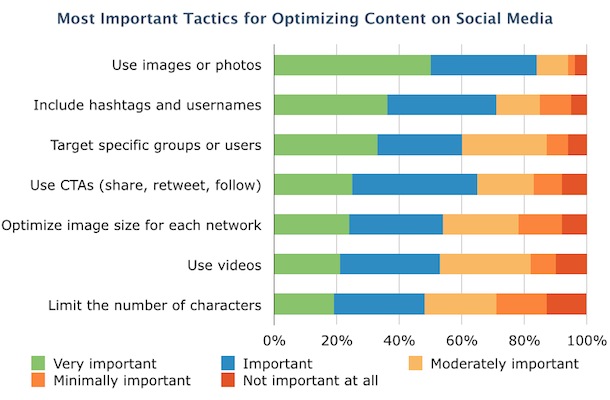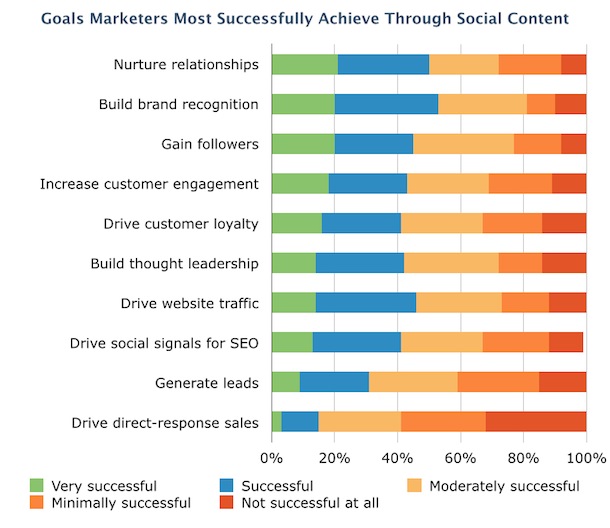Social media is a marketing monster. It provides the most powerful platform to share your message with the world. But, how do marketers break through all the “noise” on social? With so many companies sharing so much stuff, what tactics do the savviest marketers use for social media optimization across their social networks?
I came across the Social Media Content Optimization Survey, administered by Software Advice in partnership with Adobe, and I wanted to share its findings with you. Revealed in the early stages of the survey were the answers to the important questions I asked above, and more. Looks like if you aren't using images and photos in your social media distribution, you may be missing the mark.
Here is a Q&A with Ashley Verrill, Social CRM Researcher at Software Advice about the survey's findings and the most effective tactics marketers are incorporating into their social sharing strategy and execution.
The results of your survey show that using images and photos is the most important tactic to marketers on social media. Why do you think that is?
People don’t like to read--especially on social media. Also, images are easier to process and draw meaning from immediately. When I think about how I scan my Facebook newsfeed, I pretty much just quickly scroll, stopping only when I see someone’s posted a new photo; or, if they’ve posted a news article that happens to have a really eye-catching image. I think part of the reason this has happened to me, and others on social media, is that I’m now checking updates for five or more platforms a day, and my number of friends, followers, connections etc. is always growing. I don’t have the time or patience to go through every feed and read every single update. So, I just scan and look for those that “jump out at me”--usually because of an image or photo. That’s essentially what you want: photos and images that stop the social media user in their tracks.
Related Class: How To Optimize Social Media For Search
With the popularity of video apps like Vine and Instagram, are you surprised to see marketers rank video so low in your study? As video technology continues to improve and become more widely available, do you think this number will change?
No, I’m not surprised; and yes, I do expect this trend to change. As you hinted at in your question, I think the low ranking in the survey is not because videos are drastically less successful than images and photos. I think it’s because videos are so much more labor intensive. Images and photos can be just as effective as videos at “stopping social media users in their tracks,” but more often than not are significantly less expensive. However, as it becomes easier and easier to produce high-quality videos, I expect to see the ratio of images-to-video use become more even. Particularly when you consider that videos are 12 times more shared than links and text posts combined, compared with photos, which are just two times more likely to be shared than text updates.
Marketers reported that one of their top goals for using social media is to build brand recognition. What tactics do you think marketers are using to achieve this?
First and foremost, you need to focus on building your following. The more people you have interacting with your content (sharing and engaging with it) the wider net you can cast. Just having your brand seen across the web can increase recognition (seen ideally by way of others sharing your content with their friends and social circles). So, really the question is what tactics can you use to build your following. I’d say one of the biggest misconceptions is that posting engaging content routinely will get you there. It won’t. It might drum up some followers, but they aren’t likely to stay engaged. To create that stickiness, you, as a brand, must return the favor. Reply to customers that comment on your updates. Re-share their updates, or reply to their mentions. Share a healthy mix of user-generated content with brand content. Finally, make sure it is highly-relevant to your audience. Just because the latest news about Justin Bieber is the hottest thing on the Internet right now doesn’t mean you should share that with your audience.
As your study shows, driving website traffic is one of the lowest social media goals for marketers. Are you surprised by that outcome?
Yes and no. Yes, because content marketing as a whole is becoming more popular and social is one of the most-effective means for getting someone into your content marketing funnel: they read an article or eBook you shared on social, sign up for your newsletter, are marketed to over time, and eventually (ideally) convert. For that reason, I’m surprised that more marketers didn’t say yes, thinking traffic to their website would give them the chance to add them to their email marketing program. I say no because people who didn’t read that possibility in the question, might have instead been thinking traffic for the purposes of immediate conversion. That is more challenging and often less effective on social media (I wasn’t surprised that “drive direct-response sales” was the goal marketers are least effective at achieving).
To read more about the Social Media Optimization Survey, visit The B2B Marketing Mentor blog by Software Advice. And, follow me on Twitter @madisonrjacobs.

